

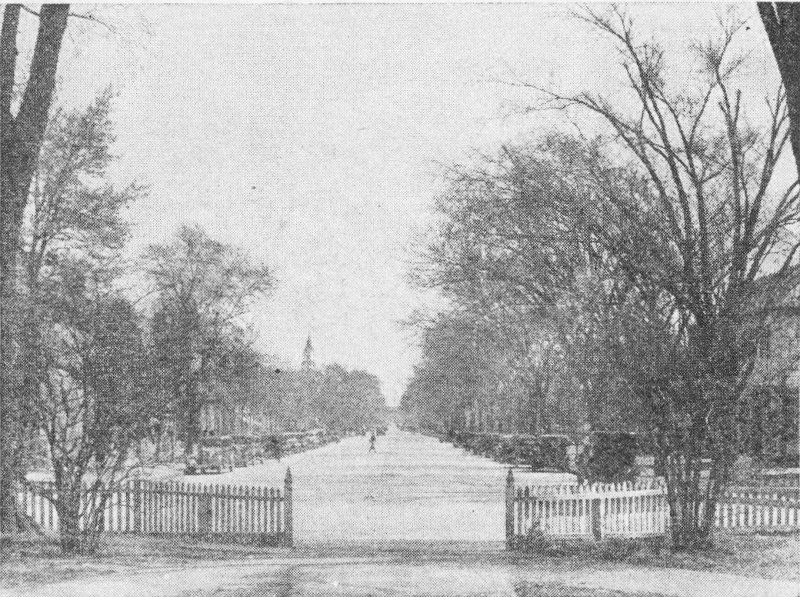
DUKE OF GLOUCESTER STREET
Copyrighted, 1943, by William C. Ewing
Illustrations on cover and page 17 are used by courtesy of
Colonial Williamsburg, Inc.
The Dietz Printing Company
Richmond, Virginia
We hope you will enjoy your stay in Williamsburg. This is the only historically important town in America which has changed so little in two hundred years.
We who live in Williamsburg love it. We hope you will stay long enough to get sentimental over it, too.
To help you get the most out of your visit we offer the following suggestions:
1. Williamsburg is not a museum. It is a living community.
2. The chief value of Williamsburg is its atmosphere. But for our having a few automobiles and new-fangled clothes, there has been mighty little change in this atmosphere since Thomas Jefferson and George Washington helped to make it what it is.
3. If you come from New York or Chicago don’t think of going inside any ancient building until you have spent at least one day in getting calmed down to our tempo and learning to wander about instead of hustling. Get into the spirit of the place.
4. Then, when you begin to feel at home and wish to see some interiors, take it easy. Go to the Church one day, the Palace another day, and so on. Imagine rushing through the Governor’s Garden!
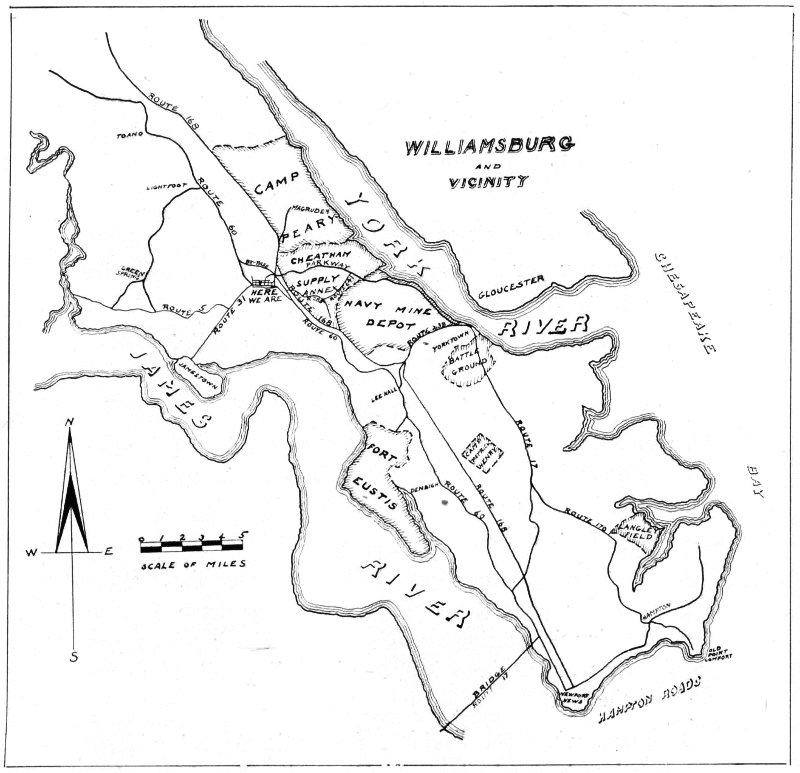
WILLIAMSBURG AND VICINITY
After the settlement of Jamestown in 1607 the population of the Virginia Colony gradually spread out from that center until, in 1633, it became desirable to develop farms in the territory between the James and York Rivers, which has ever since been called the Virginia Peninsula. From its position in relation to the rivers, this settlement was named Middle Plantation.
The privilege of dwelling in this district was granted by the colonial legislature on condition that a Palisade be erected to keep out the Indians. This palisade extended from Queen’s Creek, which empties into the York River, to Archer’s Hope Creek (now called College Creek), which is a tributary of the James. This palisade was kept in repair until 1710.
At present, only two buildings remain which were here in the 17th century: the Galt House on Francis Street and the main building of the College.
The first attempt to found a college in America had its inception at Jamestown in 1617. Land was secured near the present site of Richmond and considerable endowment was invested in farm stock. Before operation of the college could begin, the whole undertaking was wiped out by the great Indian massacre of 1622. Two generations later a group of important citizens met at the house of Col. Page to make plans for an institution which would make advanced education possible without the necessity of going to England. As a result of this meeting action was secured from the colonial legislature and Rev. James Blair was sent to London to request a charter and financial assistance from King William and Queen Mary. Not only was he successful in his main object but, at the same time, he got Sir 4 Christopher Wren to draw plans for a building which should be worthy of the College of William and Mary in Virginia. This central structure of the College, generally known as The Wren Building, was designed in the form of a quadrangle; the easterly side was constructed in 1695, the northerly and westerly wings shortly thereafter; the fourth side of the quadrangle has never been built.

WREN BUILDING—COLLEGE OF WILLIAM AND MARY
Few students in the America of today have a more magnificent inspirational background than those who attend classes in the Wren Building. Probably nowhere else did so many of the real founders of our government get their education and inspiration in the same rooms. In one manner or another there have been associated with William and Mary, Presidents Washington, Jefferson, Monroe and (in the next generation) Tyler, as well as jurists and statesmen of the most beneficent influence. And great teachers there were, too. Thomas Jefferson testified that it was from Professor Small that he received the inspiration for his life work. Bishop Madison, the first president under the Commonwealth, was a really great teacher of Natural Phylosophy, as were Patrick Rogers and his famous son.[1]

THE CAPITOL
Dr. Blair was a truly remarkable man. While in London he wrote back that he had secured the necessary teachers for the College but that he could not find anyone adequate for the presidency; but, he added, perhaps he would do pretty well, himself, in that position; and so it came about. It is perfectly clear that he was one of the leading citizens of Virginia. He was simultaneously Commissary of the Bishop of London (the highest ecclesiastical office in the Colony), Rector of Bruton Parish, President of the College, member of the Governor’s Council and thereby a judge in the highest court in Virginia. He was a man of very firm character, usually in a serious controversy with some important opponent; as a result, he secured the cashiering of three Royal Governors. One of these contests throws interesting light on academic customs, there being an annual “lock-out day” at the College. On one of these celebrations (the immediate object being the securing of a longer Christmas recess), the boys being inside the Wren Building and having nailed the doors to prevent entrance by any faculty members, President Blair superintended the forcing open of a door. During the scuffle he received the contents of a gun in his shoulder, after which he sent formal complaint to the authorities in London charging that the Governor of the Colony had armed the pupils for an attack on their president. For months thereafter criminations and recriminations traveled across the Atlantic. The Governor swore that he lent the students only the gun and powder, no bullets whatever. It 6 became apparent that what hit the President’s shoulder was only the paper which was used to ram in the powder. Nevertheless, Governor Spotswood left and Dr. Blair remained.

LUDWELL-PARADISE HOUSE
Shortly after the College began to function, a fire at Jamestown destroyed the government building. As that location was quite malarial, it was deemed best to establish a new capital on higher ground and it was decided to locate it near the College at Middle Plantation. Legislation was enacted setting off for such purpose approximately what is now known as The Restoration Area, together with approaches through Capitol Landing Road from Queen Mary’s Port on Queen’s Creek and through South Henry Street from Princess Anne Port on Archer’s Hope Creek. Since the receipt of the College charter in 1693, Queen Mary had died, leaving William III to reign alone; so the newly planned city was called Williamsburg.
This, the second planned city in America, was laid out in 1699 with the main street named for Princess Anne’s son, Duke of Gloucester Street. The center line of the street was laid out from the middle of the doorway of the Wren Building in an easterly direction so far as to make 7 the whole length of the street exactly three-fourths of a mile long. The street’s width was fixed at six poles (99 feet) and all buildings were to be kept back six feet from the street. Governor Nicholson named two of the streets for himself: Francis and Nicholson. Other streets had such significant names as England, Ireland, Scotland, France, Nassau, Prince George and York. Williamsburg being on the crest of the York and James watersheds, there were many brooks or dry ravines crossing all the east-west streets. For years Duke of Gloucester Street spanned these ravines on bridges.

THE RALEIGH TAVERN
The first public building to be erected after the laying out of the city was, naturally, The Capitol. This was located on the easterly extension of the center line of Duke of Gloucester Street, thus balancing the Wren Building on the west. Until the completion of the Capitol, the General Assembly held its meetings in the Blue Room of the Wren Building. After the completion of the Capitol it became for three-quarters of a century, the center of public activity in the Virginia Colony, the training-school of democracy, the place where Americans contended against autocracy. Here Patrick Henry made his famous “Caesar-Brutus” speech; here George Washington received the thanks of the Colony; here Thomas Jefferson secured religious freedom 8 for his State; here George Mason presented the first Bill of Rights. The rooms in this building are indeed hallowed for every lover of liberty!

BLAND-WETHERBURN TAVERN
Repeatedly, when the Royal Governor felt obliged to prorogue the Assembly for impertinence to the King, the entire membership withdrew to The Raleigh Tavern where rump sessions were held. In such gatherings, and in frequent less formal meetings at this famous tavern, many important decisions were reached in the growing contest between the Crown and its colonial subjects. This tavern appears to have been the most important informal social center in Virginia in the later years of the 18th century. In the earlier years of that century, certainly as early as 1709, this service was performed by the Bland-Wetherburn Tavern, directly across the street. This is the third oldest building now standing in Williamsburg. It was probably built by Richard Bland, Sr., about the year 1700 and was a meeting place for leading citizens after the completion of the Capitol. At various times the famous host, Henry Wetherburn, ran this hostelry and the Raleigh, opposite.
As Solomon did not build a house for himself until he had completed the Temple, so the colonial Virginians finished the building of the Capitol before beginning, in 1706, a residence for the Royal Governor. Like most great 9 houses of the period, The Governor’s Palace was not built all at once. In 1706, £3,000 was appropriated for the erection of a “house” for the Governor. What with additions and furnishings, by 1718 it had become a “palace” and the House of Burgesses was complaining of the high-handed manner in which the Governor was “lavishing away the country’s money contrary to the intent of the law.” As in the case of many another public building, the extravagance of construction cost was forgotten by later generations in their pride in the product. A traveled Englishman considered this the finest building in America and exceeded by few in England, an opinion which has never required revision. From its completion, it was occupied by all the Royal Governors down to the Revolutionary War; and then by two Governors of the Commonwealth, Patrick Henry and Thomas Jefferson. After the removal of the Capital to Richmond in 1779, the Palace was used by the army as a hospital.

THE GOVERNOR’S PALACE
After providing a residence for the Governor, the next public building erected by order of the Assembly was a Public Magazine, familiarly called The Powder Horn. From 1714 to 1775 this octagonal brick structure was used for the storage of ammunition; and for reasons of safety it was placed in an open square. This building saw the beginning 10 of the Revolutionary War, so far as Virginia was concerned. On the 20th of April, 1775, just one day after the Battle of Lexington, in Massachusetts, Governor Dunmore removed the powder so that it might not fall into the hands of the populace. Thereupon, Patrick Henry brought troops toward Williamsburg and secured the payment of £330 from the King’s Receiver General, with which substitute powder was purchased. The Governor withdrew to the comparative safety of a British warship and thus ended forever foreign dominance in Williamsburg.

THE POWDER HORN
While the Public Magazine was under construction the Colony and the Parish were proceeding with the erection of a fine new building to take the place of the antiquated structure of The Bruton Parish Church. The then-existing building, whose foundations are still in place under the sod of the churchyard, was adequate only for a small rural community. With the influx of large numbers of people for court seasons and with the necessity for dignity, if not grandeur, in the edifice of the Established Church of the Colonial Capital, the Governor, the Assembly and the Parish united in building a church which, from its completion in 1715 to the present time, has been one of the prides of Virginia, whether Colony or Commonwealth.

BRUTON PARISH CHURCH
It will probably be impossible for one to understand the helpful leadership of this church in the ecclesiastical life of Virginia without an appreciation of the great difficulty experienced in securing high-grade, or even fairly respectable, clergy in the country districts. In all church affairs Virginia was directly under the control of the Bishop of London. It is evident from the records that great pressure must have been exerted on him to send to Virginia the ne’er-do-well younger sons of British aristocrats or any other low-grade men who had been trained for the church as for any other occupation and who had at all costs to be got out of England. Governor Gooch, one of the best Royal Governors Virginia ever had, was active throughout his long and happy administration in raising the ministerial standards; it is impossible to read his letters to the Bishop of London without having the greatest sympathy for him in his Augean labors. Through all this sad experience, with the exception of the reported indictment of Dr. Dawson for drunkenness in 1760, Bruton Parish seems to have been blessed with such leadership as helped much to raise the whole colonial standard.

THE TRAVIS HOUSE
It is somewhat difficult in this generation to realize the unity of church with state in Colonial Virginia when the legislature might order sermons on special subjects. A most notable case was the setting apart by the Assembly of June 1, 1774, the day when the British were forcibly to close the 13 Port of Boston, as a day of fasting and prayer. The enactment closed with these words: “Ordered, that the members of this house do attend in their Places, at the Hour of ten in the Forenoon, on the said first Day of June next, in order to proceed with the Speaker, and the Mace, to the Church in this City, for the Purposes aforesaid; and that the Reverend Mr. Price be appointed to read Prayers, and the Reverend Mr. Gwatkin, to preach a Sermon, suitable to the Occasion.”
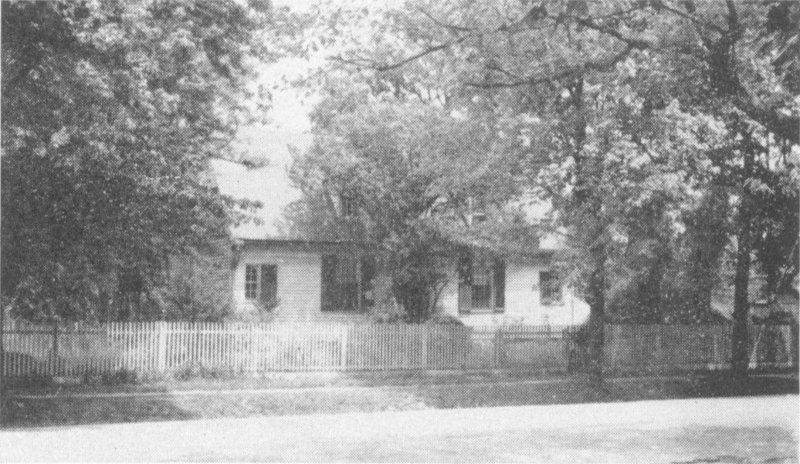
GALT HOUSE
During the first tenure of Rev. W. A. R. Goodwin as Rector of Bruton Parish, in 1905, the restoration of the church building to its early condition was begun. While no great alteration had ever been made to its exterior, the interior arrangements had been modified to such an extent as to make it scarcely recognizable. The entire arrangement, both within and without, was now returned, as nearly as available information permitted, to its condition after an enlargement that had been made in 1751.
During his second incumbency in Williamsburg, Dr. Goodwin became increasingly impressed with the possibility of preserving this old capital city as it was in its first period 14 of importance. Only a few other cities in America had the importance of Williamsburg in the founding of our nation; and the others—Boston and Philadelphia—had long since been swallowed up in great commercial cities. Williamsburg, on the other hand, had remained for two hundred years very much the same both in spirit and in physical appearance. Through the years it had continued as the county-seat of an agricultural county and the trading center of another similar one; no industries, no skyscrapers, no conflagrations had changed it. To be sure, a few modern buildings would have to be removed and a considerable number of ancient ones rebuilt. But, at that, it remained the only center of colonial political importance where a thorough restoration was thinkable.

HOME OF ROBERT CARTER NICHOLAS
In connection with meetings of the Phi Beta Kappa Society, Dr. Goodwin convinced Mr. John D. Rockefeller, Jr., of the soundness of his views in this regard and studied the situation with him in its broad features. The following year (1927) Mr. Rockefeller definitely determined to undertake, with the coöperation of the City, the restoration of the ancient part of Williamsburg to its condition as of mid-18th century—an undertaking which is probably the greatest educational accomplishment of the present century.
The restoration is not yet completed and it is unlikely that further construction will be possible during the war. It may be roughly estimated as within eighty or ninety 15 percent of completion. The First Theater in America is the outstanding public building not yet reconstructed; the number of residences still awaiting attention is indefinite but not large.
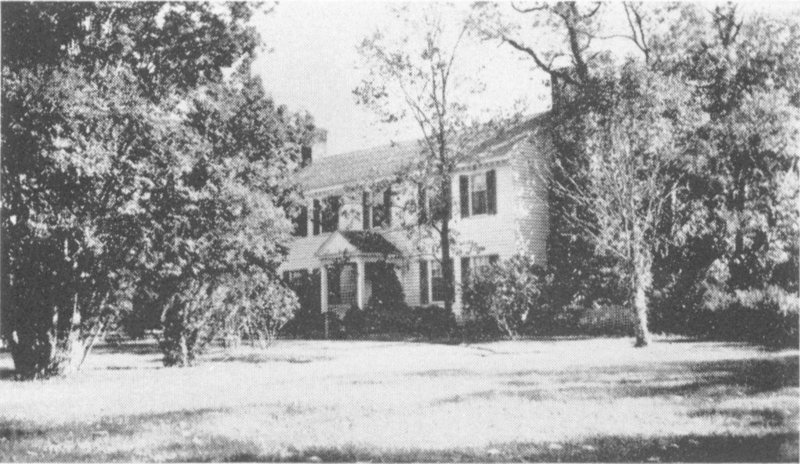
BASSETT HALL
Not far from half the buildings now standing in the old part of the city are the identical buildings which have lasted through from pre-Revolutionary days. These buildings have been thoroughly repaired, any modern additions removed and their grounds planted with such trees and flowers as probably were there in the 18th century. These buildings are technically described as “restored” in distinction from those which had been destroyed and are “reconstructed.” A comparison of each restored building with its condition just before restoration would be interesting. The principal case available is that of the Cole Shop in which hangs an oil painting loaned by Mrs. Rockefeller and showing the interior of the shop in 1938 in contrast with its present condition which is supposed to be as it was in 1780.
The most apparent change resulting from the restoration is that of Duke of Gloucester Street itself. Prior to its restoration in 1935 there were two concrete roadways separated by a strip of grass in which were unpainted wooden poles carrying electric wires. The restoration of the street illustrates very well the type of compromises which have 16 been necessary in order to keep Williamsburg an up-to-date community as it distinctly was in its first century. Thus, while the wires have been buried, the street has not been returned to its former condition of six inches of mud or dust according to the weather; but it has been finished with a hard surface nearly resembling gravel. The town has not reverted to flambeaux for the wealthy and darkness for the poor; but the electric street lights are as old-fashioned as possible. Most nearly impossible of all problems was that of fire prevention; it was solved by installing the least conspicuous hydrants in the grass and painting them green.

GEORGE WYTHE HOUSE
The first buildings to be restored were those of The College. The original building had suffered from three fires. These gave excuse for adding the beautiful wings, housing the Chapel and the Great Hall, but also gave opportunity for departure from the plans of Sir Christopher Wren; so that the architects estimate that the building as we know it (and as it was just before the Revolution) is about 50 percent Wren and 50 percent local adjustment. The cost of the third fire, which occurred while the building was in the hands of Northern troops, was reimbursed from the Federal Treasury on motion of Senator Hoar of Massachusetts.

ST. GEORGE TUCKER HOUSE
The Botetourt Statue in the front campus has had a notable history. Lord Botetourt was the Royal Governor who had repeatedly to prorogue the Assembly for action inimical to the Crown. Nevertheless, the people of Virginia respected him deeply for his personal qualities and for his sincerely democratic sentiments, realizing that his public actions were such as he was obliged to take regardless of his sympathies. So, after his death in 1770, the Assembly had this statue made in London by Sculptor Richard Hayward. The statue was erected in the open corridor of the Capitol; but during the Revolutionary War feeling against all that was English ran so high that some of the 100 percent disloyalists threw it to the ground, with casualties that still are to be seen. When the excitement somewhat calmed, and after the Capitol had been abandoned as the seat of government, the Botetourt statue was set up in the College campus, somewhat nearer the building than at present. During the War Between the States the statue found refuge with the Eastern State Hospital, thereafter being brought back to its present location. Lord Botetourt’s body is entombed in the College Chapel.
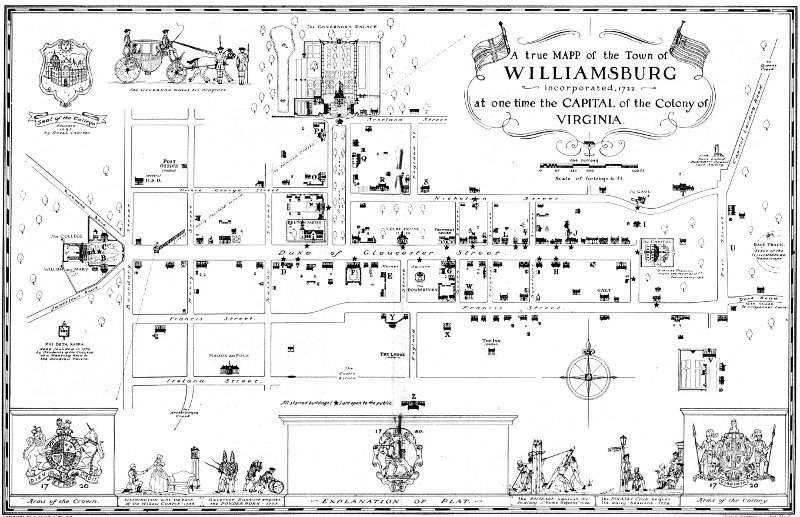
A true MAPP of the Town of
WILLIAMSBURG
incorporated, 1722
at one time the CAPITAL of the Colony of
VIRGINIA.

THE RANDOLPH HOUSE
The President’s House on the right as one faces the Wren Building and The Brafferton on the left, both date from early 18th century. The latter was originally a school for Indian boys and was supported by funds from the estate of the eminent chemist, Robert Boyle. In the 19th century, when it was no longer used by Indians, it became a home for faculty members, notably Patrick Kerr Rogers and his son William Barton Rogers who later founded the Massachusetts Institute of Technology. The Brafferton is one of the ancient buildings which has no record of a damaging fire. The President’s House was burned while it was being used by the French army and was restored by King Louis XVI.
The Palace, after the Capital was removed to Richmond, was transferred to the Army for use as a hospital, during which occupancy it was accidentally destroyed by fire. The southerly frontage of this property was later used for 21 the city’s public school. In order to return the entire site to its original condition, as called for by the restoration program, a modern school building has been erected just west of the Palace grounds; also the railroad tracks, which ran through the Governor’s Garden area, have been relocated to the north; and the entire garden as well as the Palace itself has been reconstructed. The extremely interesting research which underlies the entire restoration is well illustrated in the case of the Palace. Information regarding the design and construction of the building was obtained in such diverse places as the Huntington Library in Pasadena, California, and the Bodleian Library in Oxford, England. Fortunately, the original foundations were still in good condition.

THE COKE-GARRETT HOUSE
The restoration of The Capitol was facilitated by the fact that the colonial legislature, in ordering its erection, determined the design down to details not only of building but of furnishing. The building itself, after various vicissitudes, was destroyed by fire in 1832. The foundations were covered over and preserved by a patriotic group of women who devoted themselves to saving important historical monuments, the Association for the Preservation of Virginia Antiquities. When the restoration of Williamsburg was undertaken, they presented this site to the Restoration organization.

THE COURT HOUSE OF 1770
Another ancient building which had been preserved (and is still owned) by the A. P. V. A. is The Powder Horn, more formally known as The Public Magazine. After the Revolutionary War this building was used for a variety of purposes, including religious worship, at which time stained glass windows were installed. When the Baptist Church became strong enough to build their own edifice just to the east of the Magazine, they tore down the surrounding wall and used the bricks for the foundation of the new church. This congregation has now removed to a newer part of the town and the Powder Horn has been restored to its original condition. In this building is a collection of Revolutionary arms.
Across the road from the Powder Horn is The Court House of 1770. This is now commonly called “the Old Court House” since the location of the still older seat of city and county government (in the rear of the Powder Horn) has been used for the present modern Court House. The Restoration of the Old Court House illustrates one of the guiding policies of the restoration which is to perpetuate the old part of Williamsburg as it was in the 18th century, by no means with the object of beautifying it. In 1910 the Old Court House was consumed by fire except as to the exterior walls. In rebuilding, the structure was distinctly 23 improved in appearance by addition of columns to support the piazza roof; in its restoration the columns were omitted, thus securing authenticity at the expense of beauty. The intention has been to keep to this policy of authenticity throughout the restoration; it will be noticed, for example, that the planting in restored gardens is of 18th century plants, though in many cases modern culture has improved the species. Within the Old Court House may be seen a selection from the many tons of artifacts which have been recovered in the course of excavations about the ancient buildings.
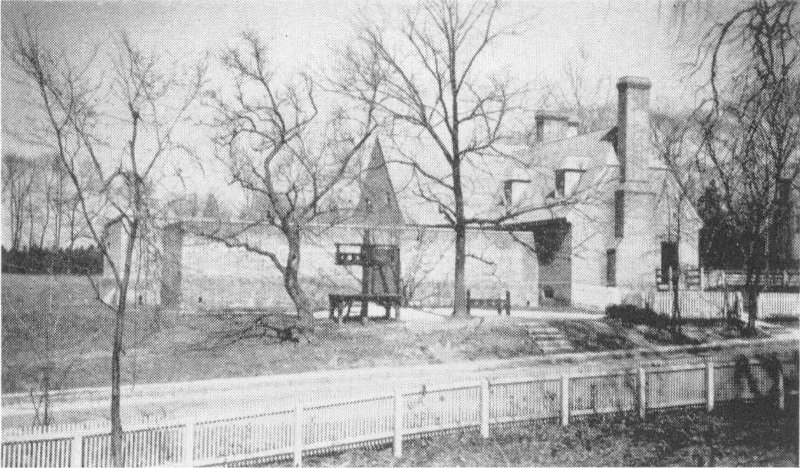
THE PUBLIC GAOL
As early as 1701, while meeting in the Wren Building, the Virginia Assembly enacted legislation specifying details not only for the Capitol but also for a Gaol (pronounced gail, not goal) to be erected on the north side of the square which was reserved for these buildings and the office of the Secretary of the Colony. Parts of the Gaol were torn down after the removal of the state court to Richmond, for Williamsburg has always been quite law-abiding. The portions thus destroyed have now been re-added to the surviving building, as also the stocks and pillory outside the wall. So the whole may now be seen as it stood when Blackbeard’s men were imprisoned and hanged here.
The final restoration of Bruton Parish Church was made during the last days of Dr. Goodwin and he was able 24 to visit it during all but the last stages. At the first service held in the completed edifice his body was buried beneath the floor of the church by the side of great men of colonial times. It has been suggested that an appropriate epitaph, referring not alone to the church but to the community, would be: If you would see his monument, look about you.

THE COLE SHOP
The Cole Shop (D) is believed to be the oldest store in America, having opened for business shortly after 1750. It was built by Charles Taliaferro, a coach and chair maker. Originally consisting of only one room, prior to 1782 another small building was moved up and joined to it on the west as a sort of lean-to, the roof-line which had theretofore been a symmetrical dormer being extended to cover the addition. At a later, but still early, date two rooms were added in the rear and the street elevation was finished off with a false front. In 1804 the shop was sold to Dr. Jesse Cole in whose family it remained until the death of his grandson in 1936.
There is no record of the type of goods carried under the Taliaferro management; but in 1827 a professor newly arrived in Williamsburg wrote thus of the Cole Shop: “I reached the Post Office which stands in the Center of Main St. It is one of the Curiosities of this Place.... There is not an Article whatever in the World which could not be found in it. It is a Book Seller’s Store in which you will 25 find Hams and French Brandy; it is an Apothecary’s Shop in which you can provide yourself with silk Stockings and shell Oysters; it is a Post Office in which you may have Glisters and chewing Tobacco & in a Word it is a Museum of natural History in which we meet every Afternoon to dispute about the Presidential Election and about the Quality of Irish Potatoes.”
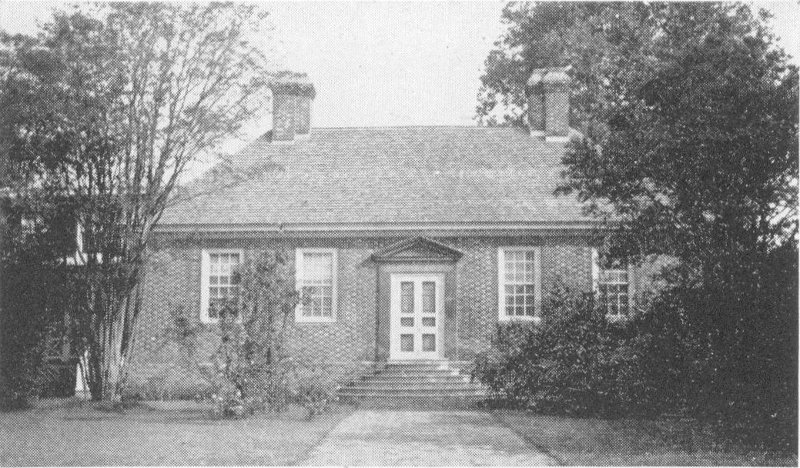
OFFICE OF THE SECRETARY OF THE COLONY
The discussion group referred to by Prof. De La Pena was the famous Pulaski Club which moves its sessions from indoors to the benches outside in favorable weather. George Washington, in his diary, refers repeatedly to attending the club at Mrs. Campbell’s Tavern (near the Capitol) but in modern times the meeting place has been at the Cole Shop. This is claimed to be the oldest men’s social club in the country; and whatever may be the members’ effect on the quality of Irish potatoes, they have effectively “saved the country” for a long time.
Le Maison des Foux (Eastern State Hospital for the Insane, to you), of which Dr. Jesse Cole was the Superintendent was founded by the Colony in 1769. It is on the site of the Custis estate where Martha Dandridge lived with her first husband. The only Custis building still standing is the small brick house which can be seen over the fence from Francis Street. This is generally known as “Martha Washington’s Kitchen.”

A PAPER MULBERRY TREE
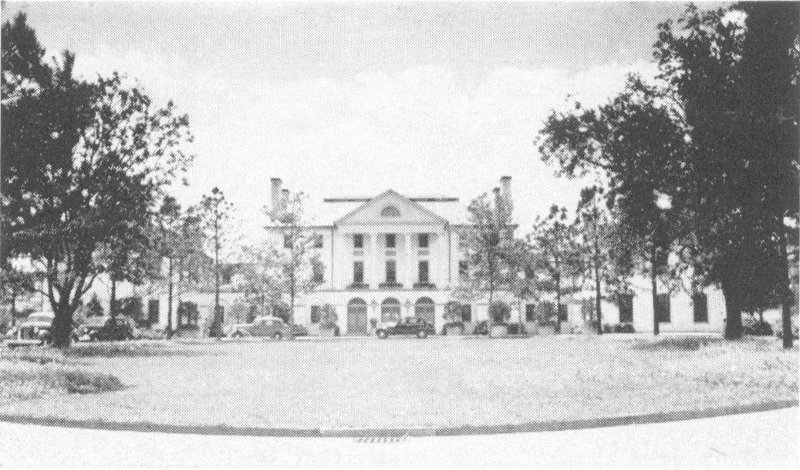
THE WILLIAMSBURG INN
The Virginia Gazette office (L) has not yet been reconstructed. The Gazette, which is now published on Prince George Street, is the oldest newspaper in the South, having been established in 1736. It probably also operated the Post Office in the early days of that institution.
The Ludwell-Paradise House (M) now houses Mrs. John D. Rockefeller’s collection of American Folk Art, ranging from cigar store Indians to oil paintings. This house was owned and occupied in the early years of the 19th century by Mrs. Lucy Ludwell Paradise, daughter and granddaughter of two Ludwells who owned this and many other Virginia estates, including Green Spring. She and her husband held the unique distinction of maintaining their home in London as the social center of American sympathizers during the Revolutionary War.
George Wythe’s House (N) was erected in 1755 and has suffered remarkably little change in the intervening years. The outbuildings were destroyed and have been reconstructed and the restored house has been furnished throughout with genuine 18th century furniture. Aside from the Palace, this is the only restored residence which is open to public inspection, all others being occupied as private homes, many of them by descendants of the original owners. George Wythe was a very substantial citizen of the late colonial and early republican period. He was a Signer of the Declaration 28 of Independence and, as first law professor in America, instructed such leaders of democracy as Thomas Jefferson, James Monroe, John Marshall and St. George Tucker.
The Carter-Saunders House, The Home of Robert Carter Nicholas (P), Treasurer of the Colony, being a fine house next to the Governor’s Palace, was close to the social center of the capital city and was always occupied by socially prominent citizens including more than one of the mighty Carters and by the Governor himself when his own residence was undergoing repairs. There is a fine garden which can be seen from the walk that connects Palace Green with West Scotland Street.
The First Theater in America (Q) has not yet been reconstructed but its location is marked on the ground. Some of the great English actors of that day came to play in this house and the social setting was gala indeed. As cited in a little book, The Sports of Colonial Williamsburg, Shakespeare, Addison, Steele, Ciber and Garrick were favorite authors in Colonial Williamsburg. This theater is the scene of Mary Johnston’s book, Audrey. The heroine was portrayed as an actress in this theater and as living in the delightful old house between the Theater and the Palace, which is therefore often called “the Audrey House” or The Brush-Audrey House, it having been built in 1718 by John Brush, armorer and gunsmith to the Governor and keeper of the Powder Magazine. In the rear of the Audrey House and the theater site is the oldest growth of box in Williamsburg; this should be approached from Scotland Street as the southerly portion of this box garden is so overgrown that it has been necessary to close it.
The St. George Tucker House (R), one of the most beautiful in Williamsburg, was ancient in its beginning and was enlarged to its present dimensions just after the Revolutionary War by St. George Tucker who came from Bermuda to study law under George Wythe and later succeeded him as law teacher and author. The house is now occupied by one of his descendants.
The Randolph House (S) was owned in 1742 by Sir John Randolph, the only native of Virginia to be knighted. This house was the residence of Gen. Rochambeau prior to the Battle of Yorktown and probably during the two years of waiting for the Treaty of Paris. Here, also, Lafayette was entertained on his return visit to America in 1824.

A PLEACHED ARBOR IN THE GOVERNOR’S GARDEN
The Coke-Garrett House (T) was begun in 1720 and added to at later times as shown by various floor levels. Altogether, it is one of the finest residences in Williamsburg and has a famous old garden which is second only to that of the Governor.
Bassett Hall (V), the only Williamsburg house with the long straight avenue approach which was so common out in the country, was built in the middle of the 18th century. It was at times a residence, at times a tavern. It takes its name from Martha Washington’s nephew who bought it soon after the Revolutionary War. Later it was owned by Abel P. Upshur, a member of President Tyler’s Cabinet and it is believed that Vice-President Tyler was visiting here when he was notified of his succession. The estate is now the home of Mr. and Mrs. Rockefeller.
Tazewell Hall (Z) gets its name from an owner who purchased it after it had been forfeited by John Randolph, the Tory, when he fled to England at the outset of the Revolutionary War. This John Randolph (who later returned and was buried in the College Chapel) was the last Attorney General under the Crown and his son, who was born in this house, was the first Attorney General of the United States. The house was moved to its present position to facilitate a real-estate development to the south; it formerly stood squarely opposite the end of South England Street. As can be clearly seen, it has not yet been restored.

THE CAPITOL TOWER
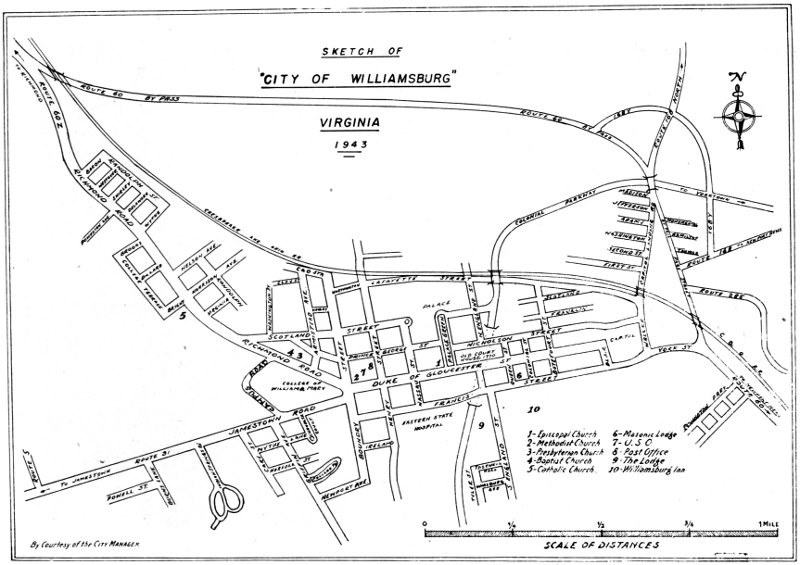
SKETCH OF
“CITY OF WILLIAMSBURG”
VIRGINIA
1943
By Courtesy of the City Manager
Williamsburg never grew substantially beyond the limits defined in 1699 until the year 1900 when the boundaries were extended at both ends of the town to take in the development of population that occurred with the growth of the College. Repeatedly since then enlargements have been made, especially as the College grew during the presidency of Dr. J. A. C. Chandler. Of late there has been building in the Capitol Landing Road district and out Jamestown Road; but throughout the present century the principal growth has been along Richmond Road. Here all the churches except Bruton have built new edifices opposite the College. The Methodists, it is true, are just inside the ancient city limits, at the College Corner. At the outset of the restoration it was determined, whether wisely or not, that the westerly block on each side of Duke of Gloucester Street should not be restored, but developed for the convenience of the residents. The shops in these two blocks are designed to be in keeping with the ancient architecture but are in no way restorations.
Just within the southern boundary of old Williamsburg, the Restoration operates two modern hotels: the Williamsburg Inn and The Lodge. The former is, during the war, reserved for military and naval officers and their families; the Lodge is still open to the general public. In either case, reservations should be made in advance, especially for weekends. Persons planning to visit Williamsburg and desiring accommodations in private families should communicate in advance with proprietors of guest-houses or with the Room Registry jointly operated by the Chamber of Commerce and the U. S. O.; and an advance deposit should be made. The reason for this is that Williamsburg (as will be seen by the 34 map on page 2) is a very small civilian island almost entirely surrounded by military and naval establishments populated by many thousands of service men whose relatives desire to visit them. It is this situation which leads to the uncertainty of reply when questions are asked as to the population of Williamsburg. Including the Hospital patients, the 1940 census showed about 4,000 residents. Up to opening of hostilities the population is supposed to have doubled.
All Williamsburg churches have regular meetings at 11 o’clock Sunday mornings; the Masons on the second Monday evening of each month; the Rotary Club every Thursday; the Lions on alternate Tuesdays. For information about other of their activities it will be well to telephone as follows:
Roman Catholic Church,
Rev. T. J. Walsh (tel. 411)
Episcopal Church,
Rev. F. H. Craighill (tel. 158)
Baptist Church,
Rev. A. F. Ward (tel. 178-W)
Presbyterian Church,
Rev. C. M. Pratt (tel. 309-R)
Methodist Church,
Rev. L. F. Havermale (tel. 384-J)
Christian Science Church,
Mrs. J. J. Montague (tel. 258-J)
Williamsburg Lodge No. 6, A.F. & A.M.,
Mr. B. C. Creasy (tel. 24)
Rotary Club,
Mr. M. W. Foster (tel. 270)
Lions Club,
Capt. W. H. Kelly (tel. 226)
The following are kept in stock and can be secured in person or by mail:
Colonial Yorktown ($3.00)
Guide Book to Williamsburg Old and New (25¢)
Homes and Gardens in Old Virginia ($5.00)
Old Williamsburg and Her Neighbors ($3.00)
Peninsula Pilgrimage ($5.00)
Photographic Studies of Old Virginia Homes and Gardens ($1.00)
Virginia is a State of Mind ($3.00)
Williamsburg, Old and New ($4.00)
Williamsburg, Virginia in Photographs ($2.00)
Colonial Yorktown ($3.00)
The Old South ($3.50)
Old Williamsburg and Her Neighbors ($3.00)
Pirates of Colonial Virginia ($2.00)
Present State of Virginia and the College, 1697 ($2.75)
Record of Bruton Parish Church ($3.00)
Virginia is a State of Mind ($3.00)
Williamsburg in Colonial Times ($3.00)
Williamsburg in Virginia ($1.00) (in leather, $5.00)
Williamsburg, Old and New ($4.00)
Below the Potomac ($3.00)
A Children’s Color Book of Williamsburg (50¢)
John Norton & Sons, Merchants ($6.00)
Journal and Letters of Philip Fithian ($4.00)
Secret Diary of William Byrd, 2 volumes ($5.00 each)
Sports of Colonial Williamsburg ($1.00)
Williamsburg Art of Cookery ($2.50) (in leather, $4.00)
Williamsburg Scrap Book ($2.00)
George Washington ($1.00)
John Paradise and Lucy Ludwell ($4.00)
Martha Washington ($2.50)
Secret Diary of William Byrd. 2 volumes ($5.00 each)
St. George Tucker ($3.00)
Colonial Twins of Virginia (for children) ($1.75)
Dawn’s Early Light ($2.50)
Linda and Dick of Colonial Williamsburg (for children) ($2.00)
Stories of the South ($1.50)
Storm Against the Wind ($2.75)
The Tree of Liberty ($3.00)
and carries a modest selection of other books of general literature and popular appeal. Any desired book that is published, if not in stock, will be secured to order. Call in or write to The Cole Shop for ANY BOOK.